
Guests
- Osagyefo Sekoupastor from the First Baptist Church in Jamaica Plain, Massachusetts, who was dispatched to Ferguson by the Fellowship of Reconciliation. He went to high school in St. Louis and has family in Ferguson.
In Missouri, Ferguson has seen another night of heavy unrest in the ongoing uproar over the fatal police shooting of 18-year-old Michael Brown. At least 31 people, including two journalists, were arrested as street clashes erupted between groups of demonstrators and riot police. Police are claiming they came under “heavy gunfire” and that unknown suspects shot two people over the course of the night. The protests came hours after attorneys for the family of Brown held a press conference to discuss the findings of a private autopsy that revealed Brown had been shot six times. The officer who shot Brown, Darren Wilson, remains in hiding and on paid leave. We go to the streets of Ferguson to speak with Rev. Osagyefo Sekou, a pastor from the First Baptist Church in Jamaica Plain, Massachusetts, who was dispatched to Missouri by the Fellowship of Reconciliation. “It is a tragedy that as a clergyperson I need a tear gas mask more than I need a collar to be able to do the work that I feel called to do,” Sekou says.
Transcript
AMY GOODMAN: At least 31 people were arrested in Ferguson, Missouri, last night as protests continued over the fatal police shooting of 18-year-old Michael Brown. The cover of today’s St. Louis [Post]-Dispatch has a banner headline reading “Streets Flare Up.” The lead photograph shows a police officer dressed in riot gear shooting tear gas.
A series of startling images were published on Twitter overnight. A human rights monitor from Amnesty International photographed a police armored car charging through the crowd of protesters. Amnesty’s Zeke Johnson wrote, quote, “Insanity as police armored car charges through crowd, lucky no one hurt #ferguson, seems so reckless,” he tweeted. Ben Kesling of The Wall Street Journal published a photo with the caption: “Just saw AR-style rifle with Harris bi-pod on top of armored vehicle. The designated marksmen out again in #Ferguson.” Amanda Sakuma of MSNBC tweeted a photo saying, quote, “Riot police aiming guns at journalists who are on the ground and holding their hands in the air”
At least two journalists were detained overnight, including Ryan Devereaux of The Intercept. Earlier in the day, police arrested photographer Scott Olson of Getty Images.
At an early morning press conference, Missouri Highway Patrol Captain Ron Johnson defended the police response, saying officers had come under, quote, “heavy attack.”
CAPTAIN RON JOHNSON: Tonight there were numerous reports of shots fired. We had two fires, one at a business and one at an unoccupied residence. In the area of West Florissant and Canfield, our officers came under heavy gunfire. Our officer confiscated two guns during a car stop near the media staging area. These are not acts of protesters, but acts of violent criminals. Our officers acted with professionalism. Once again, not a single bullet fired by officers, despite coming under heavy attack.
AMY GOODMAN: The governor of Missouri deployed the National Guard to the streets of Ferguson, but so far they’ve played a limited role, protecting the police command post. The protests came hours after attorneys for the family of Michael Brown held a news conference to discuss the findings of a private autopsy that revealed Brown had been shot at least six times. Daryl Parks is an attorney for the family.
DARYL PARKS: The first one is what we will call—what we call the kill shot, the one that, when Attorney Crump was speaking, that he wouldn’t have suffered from is right here. At the apex of his head, there is a very, very severe and clear injury, at the apex, the very top, that went from a back-to-front position. Also, the second shot to the head that you’ve heard us speak about, that shot is here. There’s a little dot on the diagram that you see right by his hairline. That bullet went in there and came out near the eye area. That’s very important, because it shows a back-to-front for both of those, and it supports what the witnesses said about him trying to surrender to the officer. And his head was in a downward position—had to be, for what had happened. Those type of facts are clear. And we believe that given those kind of facts, this officer should have been arrested. Those things speak for themselves. Why would he be shot in the very top of his head?
AMY GOODMAN: Daryl Parks, an attorney for the family of Michael Brown. The Justice Department said it will conduct its own autopsy. On Monday, President Obama announced Attorney General Eric Holder will travel to Ferguson Wednesday to meet with FBI agents conducting a federal civil rights investigation into the shooting.
We go now to Ferguson, where we’re joined by Reverend Osagyefo Sekou. He’s the pastor from the First Baptist Church in Jamaica Plain, Massachusetts, who was dispatched to Ferguson by the Fellowship of Reconciliation. He went to high school in St. Louis and has family in Ferguson.
Thanks for joining us from the streets of Ferguson, Reverend. Can you talk about what happened last night?
REV. OSAGYEFO SEKOU: Well, thank you, dear sister Amy. Last night, protesters had been obeying the order to keep moving. The crowd grew very large to several thousand, and then the police line assembled. Young people are very angry in their tremendous amount of pain, not only because of the death of Mike Brown, but because of a history of abuse by the police in St. Louis County. One young man was completely upset, unconsolable. We worked as clergy to try to restrain him, calm him down, and then all of a sudden an urban tank was deployed, and a garrison of officers came and snatched him out of our hands. Later on that evening, down the street at the other point where the military police had set up, young people were refusing to leave the street, and police deployed tear gas. I was standing there when it happened. A number of us were tear-gassed last night.
What we see now is nothing less than an occupation. I have not felt the way that I feel since I was in Palestine in 2012. In fact, I had to go through a checkpoint. I was asked for my ID to get to this media station. And so, our young people are in a tremendous amount of pain. And an officer who should have been indicted has not been indicted. And let us be sure and be clear in the reality that these young people are engaging in a rich tradition of nonviolent civil disobedience. While there is some violence, but the greatest amount of violence occurred on last Saturday when Mike Brown was shot down like a dog and left—and left in the street for four hours.
AMY GOODMAN: I know your voice is hoarse after two nights of being tear-gassed, Reverend. Two journalists were arrested last night, among the, well, it’s believed, at least 31 people, including Ryan Devereaux of The Intercept. At an early morning news conference this morning, in the wee hours, Missouri Highway Patrol Captain Ron Johnson defended the arrests.
CAPTAIN RON JOHNSON: I’m going to tell you, in the midst of chaos, when officers are running around, we’re not sure who’s a journalist and who’s not. And yes, if I see somebody with a $50,000 camera on their shoulder, I’m pretty sure. But some journalists are walking around, and all you have is a cellphone, because you’re from a small media outlet. Some of you may just have a camera around your neck. So, yes, we are—we may take some of you into custody. But when we do take you into custody and we have found out that you’re a journalist, we have taken the proper actions. But in the midst of it, we cannot—in the midst of it, in the midst of chaos and trying to move people on, we have to be safe.
AMY GOODMAN: We have not heard whether Ryan Devereaux has been out now, and it’s been many hours. But, Reverend Sekou, this issue of a $50,000 camera on your shoulder will keep you safe?
REV. OSAGYEFO SEKOU: Well, evidently a $50,000 camera will keep you safe, but being a black boy walking down the street in your own community will not. The level of police repression that we are experiencing here is unbelievable. Just over my shoulder, there seems to be hundreds of police cars. Since I have been here—I arrived Friday night—since I have been here, I’ve personally had about a hundred M-16s and AK-47s pointed at me. We were marching on Saturday peacefully, and then all of a sudden tanks appeared—urban tanks appeared out of nowhere and tear-gassed children. That it is a high-level police repression and a violation of the First Amendment, and that journalists are not allowed to do their jobs in order to be able to bear witness to what is happening here on American soil. While drones are being deployed, there are teachers who are telling me in this district that they can’t buy books for their children. And so, this ideal is just completely problematic, and that the provocation that is happening is the high level of military-style police presence here in Ferguson.
AMY GOODMAN: Reverend Sekou, before you go, as you stand there in the streets of Ferguson, last night many ministers were deployed, leaders from the community. Can you talk about your role there and if you think that role is being respected by police? And speaking of ministers, you just came from studying at Stanford University Dr. Martin Luther King’s papers. Can you wrap that into your answer?
REV. OSAGYEFO SEKOU: Yeah. Well, it is rather surreal to have spent the last six weeks as a scholar-in-residence at the Martin Luther King papers at Stanford and to get on a plane to fly home and to see the economic realities still at work some 50 years later, thinking about King responding to the Watts riots and the anger that he encountered when he went there by young people who were simply unconsolable when another young black man was shot down like a dog by a policing agency. And so, all of that added a bit of surrealness.
I was part of a group of local clergy. A lot of this work is led by local clergy, local organizations, like the Organization of Black Struggle. And so, we’ve been supporting, trying to calm young folks down, keep them out of harm’s way. I mean, it is a tragedy that as a clergyperson I need a tear gas mask more than I need a collar to be able to do the work that I feel called to do. And so, we’ve been attempting to kind of defuse the situation, de-escalate the young people’s anger, not because their anger is not righteous, that their indignation is righteous indignation, but we’re trying to protect them from the police. And so, in one of those instances—we’re attempting to do that. But let us be clear that we are engaging in work that should be not necessary in a democracy. We should not have to spend our time trying to protect children from police in their own community. And so, we’ve been engaging in that work. But the young people are unconsolable. Their hearts are broken. They’re in a tremendous amount of pain. A number of them we hear over and over again: “I’m ready to die because I don’t have anything to live for.” And so, we’re attempting to engage that in such a way that we protect them, that they might be able to live and to be able to fight another day.
And lastly, I want to say that one of the things people can do nationally is, if you are coming here—and we need more boots on the ground—please contact local organizations, particularly the Organization of Black Struggle or the PICO Network and their local organizers here, to be able to be plugged into supporting the work that needs to be done on the ground. If you’re coming—at the risk of repeating myself, if you’re coming from out of town, please contact the Organization of Black Struggle and other local organizations so you can get your directives from them.
And that we’re asking the media to continue to do your job and to tell your truth and to be able to bear witness to as the Fourth Estate. You must hold accountable police agency and government officials.
And then, lastly, State Senator Jamilah Nasheed and others have created a petition online, a MoveOn petition online, asking for the prosecutor McCulloch to be removed and that a special prosecutor to be assigned. We need an indictment. Officer Wilson should be in jail, not journalists, not the 15 young people I saw arrested trying to leave last night. He needs to be in jail. If he would have been arrested, none—most of this would not be at work. It is a failure of government, and it is a failure of policing agency, and it’s a failure of this nation. It is a crying shame. This nation has betrayed these children with underfunded schools, heavy policing and a heavy militarized experience. America should be ashamed of what it has done to its children, and we will stand with them, and we will defend them with our very lives.
AMY GOODMAN: Reverend Osagyefo Sekou, please stay safe, pastor from the First Baptist Church in Jamaica Plain, Massachusetts, dispatched to Ferguson by the Fellowship of Reconciliation, went to high school in St. Louis. His family is in Ferguson. He’s been on the front lines each night, tear-gassed a number of times. This is Democracy Now! When we come back, we stay in the streets of Ferguson, Missouri. Stay with us.

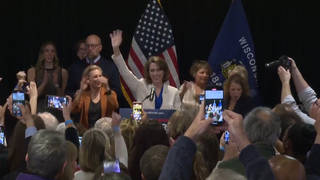
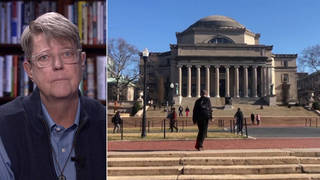
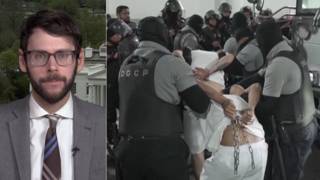
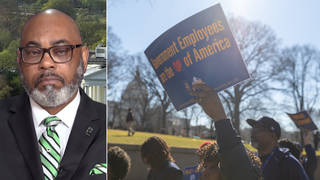





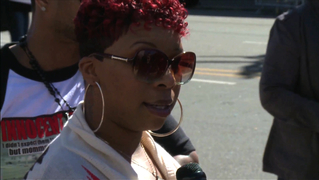
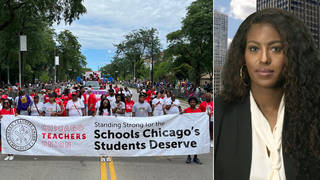
Media Options